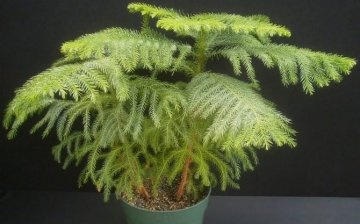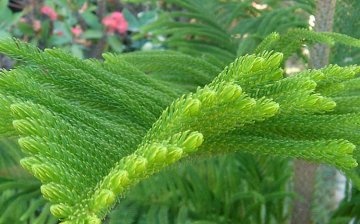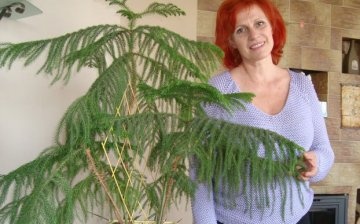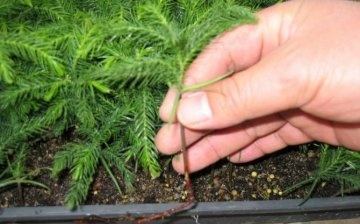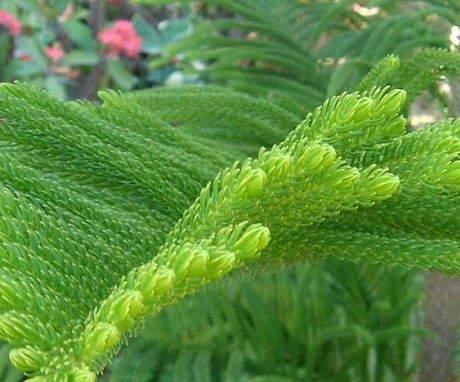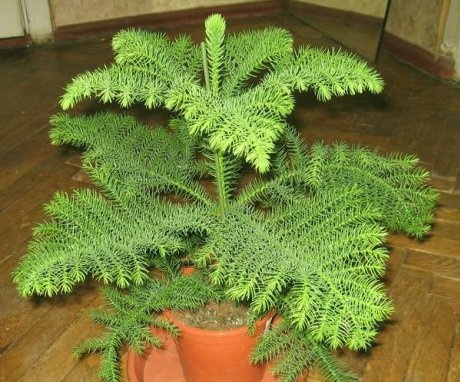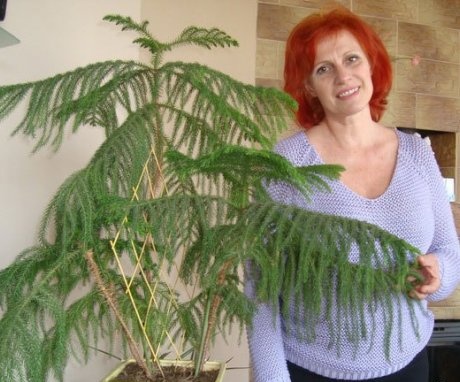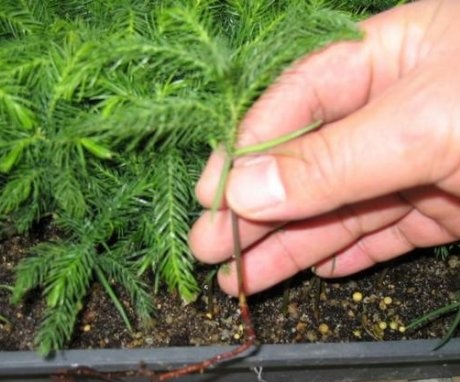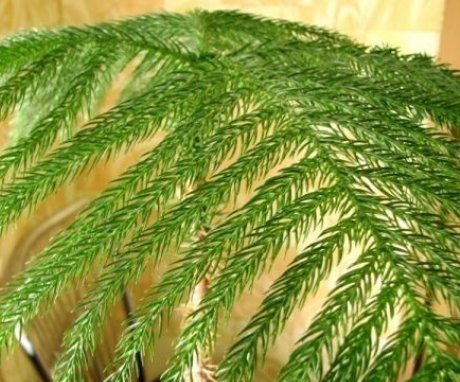Araucaria: proper care for a coniferous plant
Phytoncides of coniferous plants benefit human health, cleanse the air well of harmful substances, restraining the development of pathogenic bacteria. How nice it is to have such an evergreen tree at home!
Trees with flat needles, belonging to the Araucariaceae family, are found naturally in the countries of South America, on the Australian continent. Some species decorate parks, streets of the Crimean, Caucasian cities. But there are those that have taken root at home.
Content:
- Description of a coniferous plant
- Conditions for growing araucaria at home
- Basic rules for caring for an evergreen
- Reproduction of araucaria
- Fight against diseases and pests of coniferous trees
Description of a coniferous plant
In the rainforest growth araucaria reaches from forty to seventy meters with a trunk thickness of more than a meter. Indoor conifers have a smaller height - up to one and a half meters. The trunk of the plant is erect, the branches are horizontal or bent up. The conical shape of the crown becomes umbrella-shaped over time.
Hard needles of bright green color are up to five centimeters long and densely cover the branches of araucaria. Cones of a round color, small in ten centimeters, have seeds that look like nuts.
Indoors, two types of coniferous plants are grown: araucaria varifolia and Bidvilla.
The first has a pyramidal crown covered with soft light green needles two centimeters long. Araucaria Bidville is distinguished by its spiny glossy coniferous leaves. The similarity with spruce allowed the plant to gain popularity among indoor floriculture lovers.
Conditions for growing araucaria at home
Evergreen araucaria is classified as a fastidious plant, it requires the creation of conditions necessary for its life:
- For a plant, you need to choose well illuminated place in the house, but without direct sunlight. The duration of daylight hours at ten to twelve hours should be maintained in winter. And here artificial light lamps will help to create illumination. It will help to make the growth of tree branches symmetrical by turning it around its axis. Then the light will evenly affect the plant.
- Place the ephedra pot away from heating appliances that dry the air. This is unacceptable to him. In the homeland of araucaria, in tropical forests, the humidity is high, so it will need constant spraying. For better growth, add Epin or a few drops of succinic acid to the water. It will also help to create comfort by moistening the soil in the pot and the air of the room with the help of a pallet, where expanded clay, pebbles or moss moistened with water will be placed.
- The temperature in the room and in the house is especially important for the tree. It does not tolerate heat: in summer, twenty degrees of heat will be enough, and in winter - ten. You can put the pot on an insulated loggia for a dormant period, but with good lighting. But drafts can lead the plant to death.
Creating comfortable conditions for this unique ephedra will help to preserve the green of the needles and the symmetry of thin branches. It is undesirable to change the place of the plant, it can react by dropping the needles, turning it yellow.
Basic rules for caring for an evergreen plant
The capriciousness of the plant requires attention to it with the fulfillment of the basic requirements for care:
- Watering for araucaria it is important, since the slightest drying out of the earthen coma on the roots will lead to the death of the plant. During the growing season, it is enough to water two to three times a week, in winter - much less. The water should be at room temperature, it is advisable to defend it before watering.
- Mineral dressing for the plant, select those that are recommended for conifers. They are brought in during the active growth of the tree from April to August every three to four weeks. In winter, this procedure is optional.
- It is enough to transplant araucaria once every three to four years in cases where the pot has become small for her. A drainage layer is placed on the bottom of the selected container. Soil for araucaria is selected by mixing an equal proportion of deciduous, coniferous land, turf, peat, sand, humus. Suitable for growing and hydroponics... The method of transplanting is transshipment with the preservation of the old substrate on the roots.
If every year a coniferous tree grows by one tier of branches, then its care is carried out correctly.
Reproduction of araucaria
There are many ways to reproduce a plant: cuttings, seeds, inoculation... The most reliable is cuttings. They are prepared from April to June from the apical part of semi-lignified shoots. After drying in the shade for 24 hours, having cleaned the sections well, the prepared twigs are placed in sandy soil or a mixture of peat and sand. In this case, the soil should be well moistened. After that, the containers with the material are covered with polyethylene films, creating the effect of a greenhouse.
Reproduction of araucaria at home is a laborious and not always successful process.
Placing the pots with cuttings in a cool, well-lit room, air the plantings daily. It is also periodically necessary to water and spray them. Rooting of araucaria can take place only after two or four months. As soon as callus appears at the end of the cutting, the shoot can be transplanted into a substrate of peat and sand. And after the appearance of roots in June-July - to a permanent place.
It is possible to propagate the plant with seeds, but they must be fresh. They are planted one or two seeds in a small pot filled with a nutrient mixture. Nuts will sprout for a long time - up to four to five months.
Fight against diseases and pests of coniferous trees
Diseases araucaria occur due to improper care:
- The falling off of the needles with their drying indicates that the plant does not have enough moisture and the air temperature is too high.
- If you lose the lower branches, you do not need to worry - this is a natural process. But if their number increases rapidly, then it is necessary to create coolness for the plant, sufficient lighting.
- The pallor of the needles, the stretching of the branches occurs due to excessive watering or the presence of a pot with a tree in a draft. In such situations, the plant often dies.
- With a lack of calcium in the soil, araucaria slows down in growth.
- A damaged top of a coniferous tree can lead to the fact that it stops developing normally, stops growing.
By correcting the shortcomings of care, you can return the plant to its previous healthy appearance.
Plant pests:
- Of the pests, the most frequently attacked aphid... White droplets, secreted by the parasite, appear on the needles. The leaf-needles begin to dry out, crumble, their surface becomes sticky. The pest can be removed by hand or the branches can be washed with a solution of laundry soap. It is important here that the soapy liquid does not fall on the ground, which will have a bad effect on the root system.To repel the pest, you can place a geranium next to the evergreen.
- The sawfly larvae eat up the young shoots, and the branches begin to dry out. To combat it, insecticidal preparations such as Actellik are suitable.
- Scabbards are especially dangerous for araucaria, as they are destructive to needles, turning it into dry needles. It is difficult to find the pest - it is very small, up to five millimeters in length. But a large accumulation of them in the form of yellow or brown tubercles can be seen on the needles and stems. It is necessary to fight the parasite immediately, protecting the sick tree from healthy neighbors. You can simply wipe the affected areas with a cotton swab dipped in an alcohol solution. Processing Actellik will help quickly.
- The caterpillars of the shoots loach can easily cope with the young branches of the tree. The influx of resin formed on them leads to the death of side shoots, deformation of the main one. You can collect pests by hand or treat the bushes of a houseplant with the universal preparation Alatar.
To prevent the appearance of pests on the ephedra, one must be attentive to the pet, noticing the occurrence of problems in time.
More information can be found in the video:



